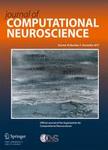版权所有:内蒙古大学图书馆 技术提供:维普资讯• 智图
内蒙古自治区呼和浩特市赛罕区大学西街235号 邮编: 010021

作者机构:Univ Edinburgh Inst Adapt & Neural Computat Edinburgh EH1 2QL Midlothian Scotland
出 版 物:《JOURNAL OF COMPUTATIONAL NEUROSCIENCE》 (计算神经科学杂志)
年 卷 期:2004年第17卷第2期
页 面:149-164页
核心收录:
学科分类:0710[理学-生物学] 1001[医学-基础医学(可授医学、理学学位)] 07[理学] 071003[理学-生理学]
主 题:cerebellum calcium mGluR temporal coding
摘 要:It has been suggested that information in the brain is encoded in temporal spike patterns which are decoded by a combination of time delays and coincidence detection. Here, we show how a multi-compartmental model of a cerebellar Purkinje cell can learn to recognise temporal parallel fibre activity patterns by adapting latencies of calcium responses after activation of metabotropic glutamate receptors (mGluRs). In each compartment of our model, the mGluR signalling cascade is represented by a set of differential equations that reflect the underlying biochemistry. Phosphorylation of the mGluRs changes the concentration of receptors which are available for activation by glutamate and thereby adjusts the time delay between mGluR stimulation and voltage response. The adaptation of a synaptic delay as opposed to a weight represents a novel non-Hebbian learning mechanism that can also implement the adaptive timing of the classically conditioned eye-blink response.